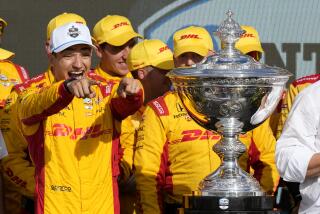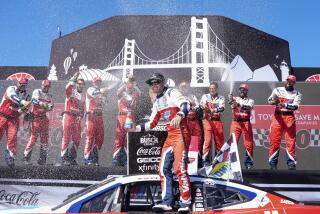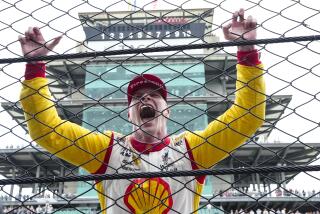Raging Gracefully
NEW YORK — Picture this scenario, NASCAR fans:
Late on a steamy summer afternoon in the Carolina sand hills, a souped-up Pontiac, heavy to the ground with a load of moonshine, comes blasting through a wooded intersection.
Lying in wait, the revenuers are suddenly jarred from their lethargy.
“Holy cow, he must be going 100. It’s gotta be Tony.”
From the speeding car comes a shout, “I’ll be back through here, guys, in a couple of hours.”
It’s pitch black outside when the same Pontiac comes racing back in the opposite direction, lights off and never slowing.
“Damn, it’s Tony and we missed him again.”
Tony Stewart didn’t get his start running bootleg whiskey in the Piedmont, as the early NASCAR champions did. He started on a little dirt track near his home in Westport, Ind., when he was 7. But the 2002 Winston Cup champion, driver of the orange-and-white No. 20 Home Depot Pontiac, is the nearest thing to a reincarnation of Junior Johnson, Little Joe Weatherly or Curtis Turner that the billion-dollar stock car organization has seen in many a moon.
NASCAR has changed as much as its drivers, shedding its “good ol’ boy” image of moonshine haulers to a slick, Madison Avenue corporate public relations look personified by Jeff Gordon. Part of that has been to take fighting -- on the track, in the garages and even verbally on TV sound bites -- out of the equation.
Back when the backwoods booze was being hauled into the cities clandestinely and the drivers met on Sundays to race for bragging rights, fighting settled the disputes. Even after Big Bill France organized them into what is now NASCAR, scrapping continued. Drivers who were cut off on the track, or insulted to their face, did not go running to the NASCAR truck to lodge a complaint -- they headed straight for a pit or garage, sometimes with tire iron in hand, to uphold their ideas of what was right.
Over the years, as NASCAR began to shed its Southeastern heritage, the sport has been sanitized. Now along comes Tony Stewart, a temper to go with his passion for driving. His dark, brooding eyes and a perpetual 5 o’clock shadow make him perfect for the Hollywood image of a bad guy.
When Stewart punched out an Indianapolis Star photographer last August at the Brickyard 400, the racing media -- which had often found him adversarial -- had a field day ripping the 31-year-old Indianan for his behavior, even going so far as to question his being able to properly “represent NASCAR as its champion.”
Stewart has a two-pronged answer.
“The smartest decision I made this year was to quit reading newspapers and magazines and not listen to TV shows about racing,” he said during a whirlwind tour of New York this week before accepting his champion’s check for $4,305,607 at Friday night’s NASCAR banquet. With season earnings and postseason contingency money, he received checks totaling $9,163,761.
“The guys are going to write what they want, no matter what I say. Some of them I respect, the ones who get out and do their homework in the garage, but some of the guys don’t do a thing but sit in the media center and take what the publicity guys hand them. I don’t have any respect for them because I know they don’t even know what they’re writing about.
“I became disappointed with the media a long time ago. So many of them thrive on controversy, so I let the media do what it does, and I do what I do best, and that’s drive.”
What about representing NASCAR?
“I didn’t sign up to be a representative of anything. I do what I came here to do. That’s run 36 Winston Cup races, and just because I came out on top in points, that doesn’t give me any other responsibilities, except to my team. If everybody wants to make it a lot more complicated than that, I’m going to be pretty disappointed.
“I’m not going to change a thing in my response to the public. It’s not an elected office. If you want an ambassador for the sport, maybe you should go get Richard Petty.”
Stewart was put to the test this week, scheduled for a media blitz by NASCAR and Winston Cup personnel.
Tuesday, he was on “The Today Show,” “Best Damn Sports Show Period” and with talk-show host Greta Van Susteren. On Wednesday, he had interviews with the New York-area media at lunch, did five-minute on-air interviews with 20 TV reporters from across the country and attended a media reception in the evening. On Thursday, he did morning radio call-in shows and participated in NASCAR’s one-on-one interviews for its 10 top drivers. And Friday he did numerous photo shoots before the banquet.
The highlight was handing over keys to a new fire engine-red Corvette to his crew chief, Greg Zipadelli, fulfilling a promise he’d made a year ago when he off-handedly said that if Zipadelli got him a Winston Cup championship, he would buy him a hot new car.
When Zipadelli came out of the Waldorf-Astoria lobby to Park Avenue, the car was parked there, Stewart grinning beside it.
“I really didn’t think I was going to enjoy this week at all,” Stewart said Friday before the awards ceremony. “You know, dealing with the media five days in a row. I thought I’d be on suicide watch by now, but it’s been great. I’m having a blast.”
For the media, it was a chance to see the other side of Stewart, a fun-loving practical joker around his friends and racing peers.
“If the fans could see us [Winston Cup drivers] for a half-hour away from the track, they would have an entirely different picture of us,” he said. “At the track, you have to be intense if you expect to win. But away from the track, we like having a good time as much as anyone else.
“We’re like 43 brothers out there, all one big family, so if a couple of us don’t mix it up once in a while, it means one of us isn’t being very competitive.”
Denny Darnell, Winston Cup’s chief representative here, has hosted four champions at the Waldorf -- Gordon, Dale Jarrett, Bobby Labonte and Stewart.
“I’m as surprised as Tony is at his behavior and his presence with the media this week,” said Darnell. “Gordon sort of set the standard for this New York tour, but I would say that Tony has handled it as well as or better than anyone. We really didn’t know what to expect from him.”
Quite a contrast from the tempestuous season that concluded two weeks ago with Stewart’s 18th-place finish at Homestead, Fla., giving him a 38-point margin over veteran Mark Martin for his first Winston Cup championship -- but his eighth title since his first go-kart race in 1978.
His collection of championships includes the Indy Racing League in 1997, U.S. Auto Club “triple crown” of sprint cars, midgets and Silver Crown cars in 1995, the USAC midgets in 1994, World Karting Assn. in 1987 and International Karting Federation Grand National in 1983.
There is one way a driver like Stewart can survive in today’s PR world -- be so good that he can’t be ignored.
Home Depot, his primary sponsor, knows that. When Stewart lost his temper and hit the photographer after the race in Indianapolis, he was fined $50,000, but wasn’t suspended.
“Tony’s an executive, really, with Home Depot and in a lot of ways he represents them corporately,” said Joe Gibbs, Stewart’s car owner. “So Bob Nardelli [Home Depot’s chief executive] is probably one of the greatest Tony Stewart fans and he knows any action by Tony would obviously have an effect on the Home Depot.
“There was just a series of serious discussions between us and them, and then we laid out a plan of what we thought was best. We were never close to saying, ‘Tony, you’re fired,’ but you obviously know that any driver here can do things that would cost him his job. So we kind of sat down and told him this is what the future needs to be like.”
There were other transgressions, but NASCAR did not suspend Stewart, as it had done with Kevin Harvick earlier. Instead he was put on “zero tolerance” probation, making him the first champion to finish his season in that manner.
“If it had been any driver other than Tony, given his history, the other [incidents] would probably not have been an issue,” said NASCAR Vice President Jim Hunter after a protest of Stewart’s actions before the season’s final race.
If he had been forced to miss a race, it would have cost him the championship.
Gibbs, who learned about taming raw personalities when he had John Riggins on one of the three Washington Redskin Super Bowl championship teams he coached, hired a sports psychologist, Jack Llewellyn, to work with Stewart on anger management.
Riggins is the former Redskin running back who, during a speech by then-Vice President George Bush at the National Press Club, leaned across a banquet table and purportedly said to Supreme Court Justice Sandra Day O’Connor, “Loosen up, Sandy, baby. You’re too tight.”
“Tony’s not really like Riggins,” Gibbs said. “Tony’s problems come from an intense personality at the race track where he wears his emotions on his sleeve and doesn’t let others enter his little world. At times, Tony steps over the line, but one good thing about him, he’s always come right back the next day when something happened and said, ‘Hey, it’s my fault.’ ”
Indeed, in interviews this week, Stewart explained, “At Indy, the cup of frustration [at finishing 12th after starting on the pole] finally overflowed. It was a negative for the weekend, but a positive for the rest of my life. I sincerely think it happened for a reason, and I am better for it.”
The team stuck behind Stewart, helping him win on the road course at Watkins Glen, N.Y., the next Sunday.
“In Winston Cup, you have a lot of tough weeks and that might have been our team’s toughest week,” said Zipadelli. “We all sat and talked about it, thought long and hard about it, and what got us to the point where we were at. A great part of that was Tony.
“We know him outside this world and he’s honestly, truly one of the best people I’ve gotten to know, hang out with and have fun with. That had to be an extremely mental week for him. Everybody was poking him, prodding at him for all that had happened the week before. He handled it well and went on and did what he was supposed to do -- get in that car, drive it to the best of his ability.”
The win moved Stewart from seventh to fourth in points and put the team in position to claim the lead with a second-place finish at Talladega, seven races from the end. Once in front, Stewart never lost the lead.
There has been no letup for Stewart since winning the championship. He was home “about eight hours” before leaving for San Diego, where his girlfriend, Jaime Schaffer, lives, and then to Irwindale Speedway for two USAC races Thanksgiving night.
“I don’t think it set in that I had won the Winston Cup until I got to Irwindale and all my old USAC buddies starting calling me Champ,” said Stewart, who won a 40-lap sprint car event before crashing in the Turkey Night Midget Grand Prix, an accident more serious than he admitted at the time.
Stewart was running third when the throttle stuck on A.J. Fike’s car, which rammed Stewart’s midget. Both cars hit the wall with a tremendous impact, totaling Stewart’s car, the one he’d won with in 2000 and had pulled out of his museum to run again this year.
“It’ll never race again, I’m sure of that,” Stewart said. “It was a mess and so was I. I took a real lick. The next day I had blurred vision in one eye and didn’t think I could race Saturday at Las Vegas.”
But he did, winning two 30-lap main events, one for sprint cars, the other for midgets.
Gibbs, asked about having a driver who risked serious injuries running open-wheel races, could only shake his head and say, “I wish he wouldn’t do it. Or I wish I wouldn’t hear about it.”
“It was a great way to relax after the grind of a Winston Cup season,” Stewart countered.
On Monday, Stewart, Schaffer, Gibbs, Zipadelli and their wives were guests of President Bush in the White House.
“It was an awesome experience to know you were standing next to the most powerful man in the world,” Stewart said. “He showed us all around the office, explaining about each of the pictures on the wall and how the presidential desk changed from president to president, depending on their size, and how it had a flap in front to hide [Franklin] Roosevelt’s [polio-shriveled] legs.
“But the best thing was when a guy opened the door and said, ‘OK, come on in,’ and about 100 photogs charged into the room, clicking off so many pictures it sounded like bees buzzing. Then, in about 15 seconds, he said, ‘OK, out,’ and they disappeared. I wish NASCAR could do something like that.”
Tuesday there was a visit to the NYPD’s Midtown precinct, an experience that gave Stewart a good message.
“I’ve sat in traffic plenty of times and got so mad at officers when I got pulled over, but they get such a bad rap, without people really knowing them as a person. I can relate to them because if you spend a half-hour with me, I’m not that bad a person, either.”
Then it was off to 85th Street and the Engine 22/Ladder 13 NYFD station.
“We met about 15 firefighters; all of them had been at Ground Zero on 9/11. One guy was the only one on his truck that survived. Seeing all those memorials on the wall made a tremendous impression on all of us. Then ... they got a call for a fire and it really hit us how these guys put their lives on the line every time they go out.
“They let me slide down the pole and that’s when I found out how much I was hurting from that Irwindale crash. I had aches everywhere.
“I told Joe that even if I don’t come back here as champion next year, I’m coming back and visit these guys. They are something special.”
That night, he and Schaffer and some friends saw a Broadway show, “Mama Mia.”
“Now that may be the biggest surprise of the week,” he said, “Tony Stewart dressed up in a coat and tie, going to a Broadway show. I can hardly wait to hear what the guys back in Rushville [Ind.] say when they hear about it.”
More to Read
Go beyond the scoreboard
Get the latest on L.A.'s teams in the daily Sports Report newsletter.
You may occasionally receive promotional content from the Los Angeles Times.










